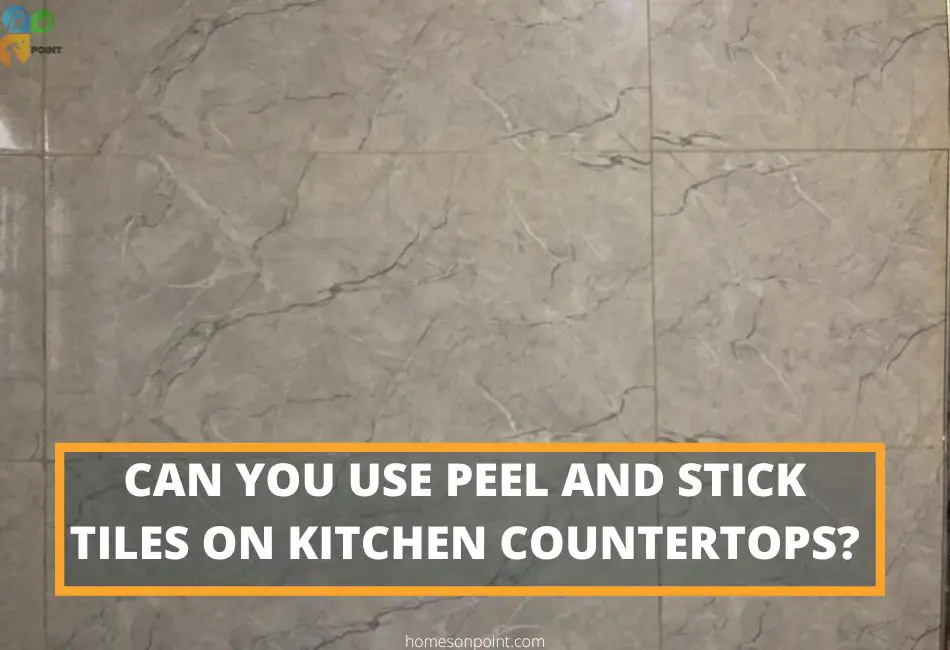Peel and stick tiles have revolutionized the home improvement process, making it easy to update your floors or walls in no time. From traditional marble designs to sleek monochromatic patterns, these adhesive tiles come in a wide variety of colors and styles, making it simple to find the perfect look for your living space.
But can peel and stick tiles be used on kitchen countertops?
Certainly yes! Peel and stick tiles have become increasingly popular for DIY countertop improvement projects. They have become a great option for kitchen countertops when people are looking for an easier and more cost-friendly renovation.
Not only are these tiles quick to install, using simple cutting and peeling techniques, but they also come in a wide variety of colors and designs that can fit any aesthetic goal. Although they’re generally considered better suited for accent pieces rather than entire countertop surfaces, peel and stick tiles offer great versatility when it comes to creating unique looks.
For the benefit of those who don’t know what peel and stick tiles are, here is a simple description.
What Are Peel and Stick Tiles?
Peel and stick tiles are exactly that – tiles that you can simply peel off the backing paper and stick onto your countertop. They come with a self-adhesive backing which allows the tiles to be installed without grout or extra tools.
Generally speaking, the most common peel and stick tiles materials are vinyl composite tile (VCT), ceramic, or porcelain tile but they came in a variety of colors and patterns.
Benefits of Using Peel and Stick Tiles on Countertops
1. Ease of Installation
The most obvious benefit of using peel and stick tiles on countertops is the ease of installation. You can easily transform your kitchen in no time without having to hire a professional contractor or use any special tools. Just measure the area you want to cover, cut the tile accordingly with scissors or a craft knife, peel off the backing paper, then press it into place. That’s it.
There’s no age restriction so everyone can be involved in the home decoration process, from kids to grandparents.
2. They are Affordable
Peel and stick tiles are relatively affordable compared to traditional tiling options, so they are great if you’re working on a budget but still want to make an impactful change in your kitchen.
3. Design Creativity
Finally, you can get creative with your design by mixing different colors or patterns together to create a one-of-a-kind look for your countertop.
How To Install Peel And Stick Tiles Properly On Countertops
Installing peel and stick tiles on countertops is surprisingly simple. Here are the tools you’ll need and the process:
What You’ll Need
- Peel and stick tiles for countertop
- Craft Knife/ any cutting item
- Tape measure
- Marker
- Cutting board
- Silicone
- Tape
The Process for Installing Peel and Stick Tiles on Countertops:
Step 1: Prep the kitchen countertop
The first step of any successful peel and stick tile installation is to ensure the surface of the countertop is clean and free from debris. Otherwise, dirt, dust, or even old adhesive may keep the tiles from adhering properly.
If you have old contact paper on your countertop, you’ll need to peel it off before you begin. Using a sponge and damp cloth, scrub and wipe the countertop with warm water and detergent to remove any grease or dirt.
Make sure to let the countertop dry completely before continuing.
Step 2: Repair any loose parts on the kitchen countertop
If there are any loose parts on your countertop, you’ll need to repair them before beginning the installation process.
For example, if the laminate at the edge of the countertop is swollen or peeling off, you’ll want to take a putty knife and some glue to reattach it before fixing the tiles. You use caulk or epoxy to patch any cracks, holes, or gaps that may be present.
If you don’t fix them and you go ahead to install the tiles on top, they won’t be secured and the tiles could end up falling off.
Remember to use a damp cloth to wipe the surface again and make sure it is dry before continuing.
Step 3: Start peeling and arranging the tiles on the horizontal surface
Once the surface is prepped and ready, you can start fixing the tiles. All you need to do is remove the tile backing that is there to protect the adhesive and take it to the surface where you want to put it.
Consider starting in a consistent corner or along an edge so that each row of tiles can start or end evenly. Peel off one tile at a time and work your way across the surface of the countertop. Apply enough pressure on the tiles so that they adhere to the surface properly.
As you approach the edges of the countertop or the edges of the sink, you may have to trim some pieces of the tile to fit perfectly on the surface.
Using the tape measure, measure the small spaces on the countertop and then measure the same on the tile then mark the size you need with a marker.
You need to be very careful with this process because if you don’t measure very well or cut the wrong side, you are going to waste a lot of tiles.
Cut through the tile with a craft knife or scissors on the cutting board and then peel and stick it into place. To help you cut right, you can use a straight edge to guide the cut.
Take your time when cutting because if you don’t cut it the right way, you can chip the edge of the tile.
Continue this process until all of the tiles on your countertop are in place.
Step 4: Fix the vertical edges of the countertop
Continue with the vertical edges of the countertop, that is the part facing you if you are standing. In the same way, measure the necessary tiles for the vertical edge and cut them to fit the space.
Once the pieces are ready, you can start fitting them in place.
As you fix them, use tape to hold them in place so that they get enough time to stick properly and are not affected by any external force.
Step 5: Caulk the edges around the sink
To prevent water from going under the tiles and messing up the adhesive, you need to use caulk or silicone around the sink.
Apply it all around the edges of the sink and then spread it evenly with a caulking gun. This will give you a more finished look and help protect the tiles from water damage.
Step 6: Let the adhesive cure and enjoy your new countertop
Once you have all of the tiles applied and the caulk is in place, you’ll need to give your countertop some time for the adhesive to cure. This usually takes around 24 hours. Then you can remove the tape and enjoy your countertop.
With patience and a few steps, you can easily install peel and stick tiles on your kitchen countertop.
Which Countertop Surfaces Can You Put Peel And Stick Tiles On?
Peel and stick tiles can be used on a variety of countertop surfaces including laminate, granite, and ceramic. it is however important to prepare the surface properly before installing the tiles to ensure they adhere properly.
The key is as long as the surface is clean, smooth, and dry, you should be able to install peel and stick tiles on it with ease.
Tips For Maintaining Countertops With Peel And Stick Tiles
Taking care of your countertop with peel and stick tiles is no different from countertops with regular materials. Here is a summary of some maintenance tips:
- Regularly wipe down the surface with a damp cloth.
- Avoid placing hot items directly onto the surface. Use heat-resistant protectors
- Make sure no chemicals or harsh cleaning agents come into contact with the surface. If they do, wipe them off immediately.
- If necessary seal edges around the perimeter where extra protection is needed to prevent water from seeping through.
- Refrain from dragging heavy objects across the surface which could cause damage over time.
- Avoid cutting directly on the surface or using it as a chopping board.
How Long Do Peel & Stick Countertops Last?
Averagely, countertops with peel and stick tiles can last up to five years if they are maintained properly.
However, its lifespan is largely dependent on its usage. Some can last up to 10 years because they are not abused and are cared for properly. If your kitchen and your countertop for that matter experience a lot of traffic, then you are sure to experience wear and tear much faster even with a quality peel and stick tile.
Final Words
Peel-and-stick tiles are an easy way to upgrade your kitchen countertop without having extensive knowledge about tiling or spending too much money on expensive materials like granite or marble.
However, it is important that you take proper care and follow the best practices when installing them. Take your time with the installation and don’t rush it and you’ll enjoy the end result.

